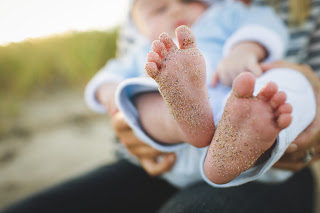I am an IBCLC (International Board Certified Lactation Consultant) in private practice in Northern Ireland and a La Leche League Leader with La Leche League of Ireland
Having problems with getting a comfortable latch? - Don't forget your baby's feet!

Photo by Danielle MacInnes on Unsplash
Positioning and attachment is key to allowing a baby to open the mouth wide and attach deeply to the breast, and in turn that deep attachment is key to a comfortable, pain-free breastfeed. We want some breast to be in baby's mouth rather than just the nipple, so that the nipple is positioned away from hard tissues like the gums and instead is framed by the wide palate and a soft tongue.
In earlier blogs I have talked about the importance of laid back feeding positions in order to trigger a baby's innate feeding reflexes to get a comfortable deep latch. Often when I describe these positions, people they tell me that they've tried it but just can't seem to make it work and their baby doesn't seem to be able to latch on. Often when I see them we work on tiny adjustments to help the baby find it's feet - literally. I often spend time talking about feet and feet placement - which might seem unrelated to breastfeeding on the face of it, but in fact is hugely important.
Babies use their feet when latching on. They are part of the beautiful and intricate pattern of reflex behaviours that lead to an instinctive latch on.
In a 2008 study by Diane Colson, researchers noticed that mothers performed the same very specific movements in order to trigger feeding reflexes. These are part of a mother's feeding reflexes. They found that when mothers were in a laid back position with hands free they stroked their baby's feet which triggered toe fanning and toe grasping, which in turn triggered lip and tongue reflexes and helped the baby to attach to the breast and to feed. You can think of this also in terms of how we are often told to tickle a baby's feet if they are falling asleep at the breast. It's not just to wake the baby up, it's to specifically trigger feeding.
Hands on therapists, such as craniosacral therapists, osteopaths etc often work with long fascial lines in the body, and what's called the "deep front line" does run from the feet at one end right to the hyoid bone and muscles at the other. As I explained in this blog, the tongue is attached to the hyoid bone and jaw and tongue movement is affected by hyoid muscles, so this may be part of the system link between that foot pressure and feeding reflexes.
On a more basic observational level however, babies just need to use their feet in order to feel positionally stable and to be able to adjust their bodies to latch on well. If you have ever seen a video of the breast crawl after birth (where a newborn crawls to the breast and self attaches), you will see how important feet position is. The baby plants it's feet on mum's body and then pushes forward, pulling the legs up, planting them in and then pushing again. Moving like this, the baby feels stable, and it also allows the chin to deeply contact the breast which again aids in getting a deep attachment at the breast. If a baby doesn't have this kind of contact, or doesn't feel positionally stable at the breast, it is much harder to get a good comfortable attachment.
So if you are struggling with getting a comfortable feed and you just can see that there is a shallow attachment and just can't figure out how to get it any deeper, look at your baby's feet. Are they in contact with something - either you or perhaps a cushion? If you are in a laid back position perhaps try having your baby lying along your body with feet against your thigh, or at at 45 degree angle with feet against your groin. If you had a C-section and want to protect your wound you can have baby more across your body, but just check that your baby's feet are touching your side, or your arm, or a cushion. If you prefer to use a cradle hold, make sure that you are also allowing your baby to feel positionally stable by ensuring that baby's whole body is firmly against yours with chin touching the breast and feet against something. If you are still struggling in either position - take another look at the hips. Both of your baby's hips should be touching you - your baby's pelvis should be flat against you - like froggy legs. If one hip is against you and the other is angled away - your baby may not have good positional stability.
I often think there is too much focus on "the latch" in breastfeeding. The latch is vitally important, but lots of things feed into "the latch" and how a baby attaches. Good attachment isn't all about the lips flanging or lining up nose to nipple etc. Its about a bigger picture of how 2 people move, how comfortable and stable they both feel and how that leads to a comfortable feed. Help your baby to find it's feet.
If you have any questions about a consultation or would like to arrange to meet, please get in touch.
Further Reading
References
Optimal positions for the release of primitive neonatal reflexes stimulating breastfeeding. Colson et al 2008 Early Hum Dev. 2008 Jul;84(7):441-9. doi: 10.1016/j.earlhumdev.2007.12.003. Epub 2008 Feb 19. - https://www.ncbi.nlm.nih.gov/pubmed/18243594
Videos showing laid back breastfeeding - https://www.youtube.com/playlist?list=PLpJt_90JhxkPJ6wQ-6VNggkqw0aWCfRD3
Fascial trains - The Deep Front Line http://healingartsce.com/advancedanatomymyofascialpg4.html
and https://www.burrelleducation.com/wp-content/uploads/2014/11/What-are-the-Myofascial-Lines.pdf
Important Information
All material on this website is provided for educational purposes only. Online information cannot replace an in-person consultation with a qualified, independent International Board Certified Lactation Consultant (IBCLC) or your health care provider. If you are concerned about your health, or that of your child, consult with your health care provider regarding the advisability of any opinions or recommendations with respect to your individual situation.
